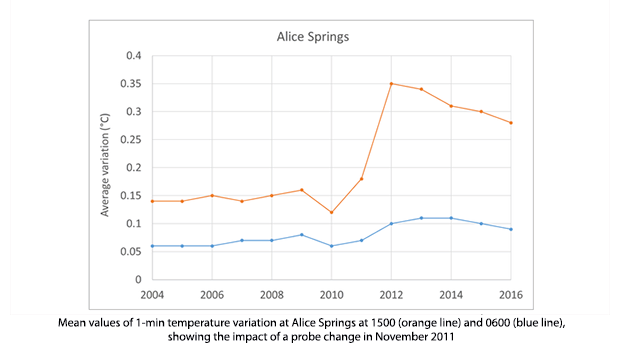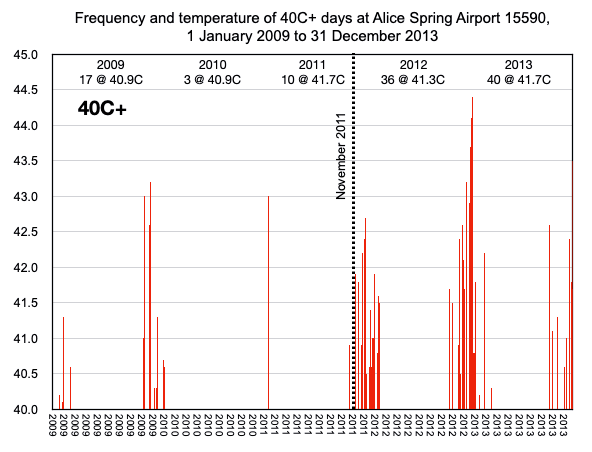On 11th November 2011, the Australian Bureau of Meteorology replaced the probe in the automatic weather station measuring temperatures at the Alice Springs airport and the number of days with temperatures recorded above 40 degrees Celsius increased dramatically. This is likely to have everything to do with the change of equipment and nothing to do with the weather. To know this for certain, the bureau needs to make the parallel data for Alice Springs airport public, that is the daily temperature data recorded manually from a mercury thermometer at the same weather station from 21st March 1991 until at least 1 April 2019 (metadata here).
Alice Springs is close to the centre of Australia, and there are very few other weather stations in the region. Because the Bureau, and other IPCC-affiliated institutions, use a gridded method for calculating climate variability and change, and because weather stations are far and few between in the centre of Australia, temperatures as recorded at this station disproportionally affect not only the calculation of the average temperature for Australia, but also the global average temperature.
While Alice Springs is a globally important weather station, I doubt it is reliably recording temperatures.
I have explained in earlier posts within this series that the bureau uses a selection of different types of custom-designed probes and that it does not numerically average with the highest instantaneous spot readings becoming the maximum for that day. We also know that while there was a mercury thermometer also recording temperatures beside the probe in the Stevenson Screen in the Alice Springs weather station for at least 28 years, the bureau will not allow the 28-years of data from this mercury thermometer to be made public. The Bureau has denied every Freedom of Information request I have so far been a part of, and our most recent request is still under consideration (in mediation) with the Administrative Appeals Tribunal. Making this data public would be a quick way of confirming whether the probe in this automatic weather station is, or is not, reliably recording temperatures.
To be clear, since 1996 the Bureau has been transitioning from manual recordings of daily temperatures from liquid in glass thermometers (mercury for maximum temperatures and alcohol for minimum temperatures) to an automated system using probes, with the probes more responsive to fluctuations in temperatures and therefore likely to record both hotter and colder for the same weather – except the Bureau has placed limits on how cold temperatures can be recorded.
In the Bureau’s Research Report No. 032 ‘The Australian Climate Observations Reference Network – Surface Air Temperature (ACORN-SAT)’ Version 2 (October 2018) Blair Trewin states:
In the absence of any other influences, an instrument with a faster response time will tend to record higher maximum and lower minimum temperatures than an instrument with a slower response time. This is most clearly manifested as an increase in the mean diurnal range. At most locations (particularly in arid regions), it will also result in a slight increase in mean temperatures, as short-term fluctuations of temperature are generally larger during the day than overnight.” (Page 21)
The limited parallel data that I have from the Bureau’s Mildura weather station shows that for the same weather the third probe installed at Mildura on 27th June 2012 often records 0.4 degrees Celsius warmer than the mercury thermometer during summer. I have also explained that on the very hottest days from June 2012 until January 2015 (the period of available parallel data) the observer did not enter a value from the mercury onto the A8 Form. I suspect because the discrepancy between the value from the probe and the mercury was so great, this data was denied – was never enter into the official record.
It is evident from calculations and charting by my friend and colleague Chris Gillham that after the new probe was installed at Alice Springs in November 2011 and compared with 2009-2010, there were 56 more days at or above 40 degrees Celsius (see chart that features at the top of this blog post).
What is now critical is for the bureau to make public the measurements from the mercury thermometer that has been recording temperatures in the same weather station at Alice Springs since 21st March 1991 through until at least April 2019. These 28 years of data would enable some comparison with temperatures from the new probe at Alice Springs that I hypothesis is hyping maximum temperatures and thus the global average temperature given the significance of Alice Springs to national and global temperature databases.
Mercury thermometers were used to measure official temperatures at Alice Springs until 1 November 1996.
According to the Bureau’s 2020 publication ‘An updated long-term homogenized daily temperature data set for Australia’, the Bureau tested one second variations within the minute at 6am and 3pm for replacement temperature probes at 98 official weather stations. The Bureau reports an average increase in 1-minute temperature variation of approximately 0.2 degrees relative to the previous probe at Alice Springs, while dismissing this as insignificant. The breakpoint is visible, and the comparison is only with the previous probe, giving no indication of the difference relative to a mercury thermometer or how this affects record hot days. To properly evaluate the effect of the replacement probes at all 98 official weather stations the available parallel data from mercury thermometers recording temperatures at the same weather stations needs to be made public as a matter of urgency.

In the absence of access to the parallel data – and the absence of any quality assurance and credible research into issues arising from the transition to probes by the Bureau – no reliability can be placed on any claims by the Bureau and/or other scientists using their data, of record hot days, fewer extreme cold days or the claimed accelerated warming trend, or anything similar.
To be clear, we cannot know if the 1.5°C tipping point is imminent or if we have significantly more time. It could be the case that we have more time, if most of the probes at most of the 695 automatic weather stations spread across the landmass of Australia, like the probe currently recording at Mildura, are sometimes measuring up to 0.4°C hotter for the same weather.
The extent of any contrived warming is likely to vary with the type of custom-designed probe and the local environmental conditions. As Blair Trewin wrote in the Bureau’s 2018 report (page 21): in arid regions an electronic probe is likely to generate higher maximum. This hypothesis could be easily tested if the Bureau provided access, for example, to the 25 years of parallel data for the desert location of Giles.
Access to this data from Giles was requested under Freedom of Information by John Abbot on 9th November 2017, and denied by the Bureau on 14 November 2017.
***
The chart featuring at the top of this post was drawn by Chris Gillham as part of a series of reports that we are working on together, focusing not just on the change to probes in automatic weather stations but also the switch from Fahrenheit to Celsius and associated discontinuities in the historical temperature record.


 Jennifer Marohasy BSc PhD is a critical thinker with expertise in the scientific method.
Jennifer Marohasy BSc PhD is a critical thinker with expertise in the scientific method.

In the absence of transparency by the BOM it seems the only way to establish the actual temperatures is to have independent instrumentation erected in a few of these critical sites such as Alice Springs and Mildura. There would surely be sufficient supporters prepared to contribute to the cost of such weather stations.
It seems the bureau will do anything to protect the dominant narrative that global temps are rising. I like the idea of independent instrumentation proposed by David Houghton. With support for the hardware and data collation, support should grow to put real pressure on the bureau to release the data it so zealously protects.
Q: Why isn’t this widely reported in the Australian media? A: Before the 1990s, when investigative journalism was the norm, there was always a balancing act in exposing government stuff like this. It had to be a big story and this would qualify here and the media would run with it until the agancy fixed the corruption. It was well recognised that government agencies exposed for corruption would retaliate by cutting off media releases, so it had to be a big story that would hold an audience because of the need to know about the problem and to fix it. Media releases now comprise a large amount of information published as news. So in the old days, this temperature massaging would have got a real airing in the media. The media’s march into global news cut out swathes of local investigative news. Global news is cheaper and supposedly more lucrative except most people don’t want to watch a list of the worst things that happened in the world that week – they do not need a depressing saga of negativity that has little relevance and that they can do nothing about.
Much thanks to Anthony Watts and Charles Rotter for reposting at WUWT, and if any one wants some insights into the true nature of Bill Johnston’s character, they are on display in the thread that follows the post:
https://wattsupwiththat.com/2023/02/15/hyping-maximum-temperatures-part-6/
Hi Jennifer, It amazes me that they ( BOM) can get away with this falseness, how do we get this info out there, many thanks for this valuable info
Regards
Karl Penna, Mapleton